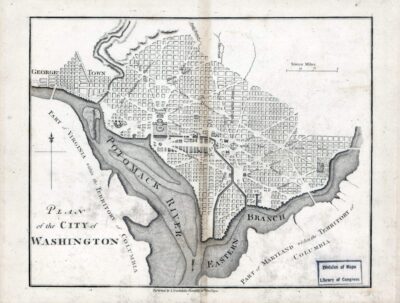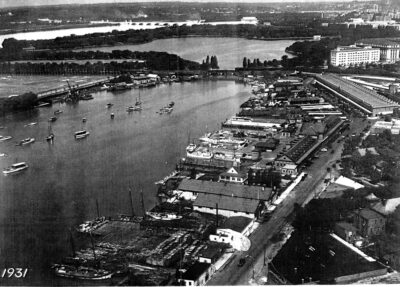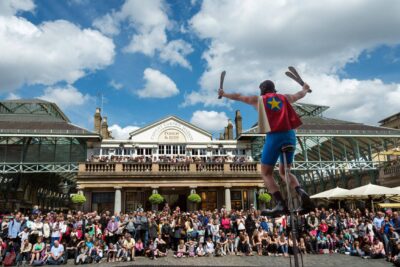Re-Imagining Urban Sites
Abstract
A presentation of the thoughts of Stan Eckstut, one of America’s foremost urban designers, on reimaging urban sites. Eckstut draws out four key principles of design that underpin his approach to creating new districts and large scale urban redevelopments but in fact have universal applicability to projects at all scales as evidenced in his work. He emphasizes the importance of placing the public domain and creation of iconic public spaces above architecture alone. This presentation is in the form of a mini-documentary captured through a video and accompanying transcript.
About the Author
Raeburn Chapman is Founding Editor of Urban Design Review. He is an architect, urban designer and city and regional planner who has worked across academics, research, private practice and government internationally. In Australia he was responsible for introducing urban design as public policy into the transport sector of the New South Wales state government. Contact: editor@urbandesignreview.com
Introduction
Stan Eckstut, a Fellow of the American Institute of Architects, is a “city making” architect who is steeped in urban design policy and practice.
After being a member of the Urban Design Group in the City of New York, he served as Director of the Urban Design Program at Columbia University. He has practiced architecture for five decades leading large design firms, including Perkins Eastman. His many built urban redevelopment visions have combined urban design and architecture into transformative results from Battery Park City, New York to The Wharf, Washington, D.C.
He is the protagonist of the recent mini-documentary video: “Thoughts on Reimagining Urban Sites.” This was produced by the Pittsburgh History & Landmarks Foundation, a private non-profit organization whose aim is to preserve and build better cities. It targets a lay audience – including public officials, lawyers, developers and general public – who engage in major urban redevelopment projects and need some help but, as Stan Eckstut says, may have import for professional architects and urban designers as well.
Contact: seckstut@stantoneckstut.com
The video
Stan Eckstut presents his ideas and experience while walking the grounds of one of his most recent projects, The Wharf in Washington, D.C. His presentation may be accessed by clicking on the video below titled: Reimagining Urban Sites.
Title: Reimagining urban sites
A modified transcript of the video follows.
The Transcript

Figure 1:The Wharf, Washington, D.C.
We are here to talk about how to do large development projects. The focus is on redeveloping existing built-up cities and urban places, typically with local traditions and a long history. Sites could be anywhere from 15 to 100 or 200 acres. In American cities they tend to be large sites that were formerly industrial, a rail yards or a waterfront and may have redeveloped several times. Wharf D.C. is a significant waterfront redevelopment.
Each city is unique and each location one of a kind. There is much to be learned from existing resources, including the past and history, hence no real need to start from scratch. In fact, you should not want to.
- Figure 2. Historic Plan of Washington D.C.
- Figure 3. Historic waterfront, 1931
We are trying, above all, to make real places, not projects. In doing so, we are relying on precedent, in this case, local precedent. As you can see, we wanted the buildings to look like the real Washington, D.C. and not the Federal D.C. While we could have done so, we recognize that this is the real neighborhood where brick is an important part of the city’s legacy.
- Figure 4: Looks like real Washington
- Figure 5: Cody’s Alley in Georgetown neighbourhood of Washington, D.C.
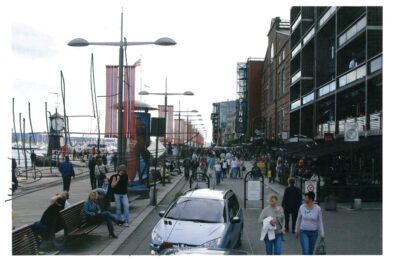
Figure 6: Oslo Waterfront, Norway
There is much to learn from others whether nearby, in the same region or from afar. The idea is to not copy anything from anywhere or to otherwise reinvent the wheel, but to rely on precedent. It is important to listen, learn and interpret from what has been accomplished in various places.
- Figure 7: Covent Garden, London, event
- Figure 8: Covent Garden, London, restaurants
In every plan, we seek to make at least ten different environments that cause people to stay longer, come back and visit more often – as is the case in older cities where, in a comfortable walk, you can encounter many different experiences.
We have lost a lot of that in modern development.
First and foremost, our focus is always on the ground plane, which is where everyone engages with buildings, walking being the defining measure of cities, critical to how they function and are experienced. Cities may have the cars, vehicles and trucks they of course need but these are not the inspiration for the city design and city fabric, unless you have cities such as those designed primarily for moving traffic through quickly to get people in and out from nine to five.
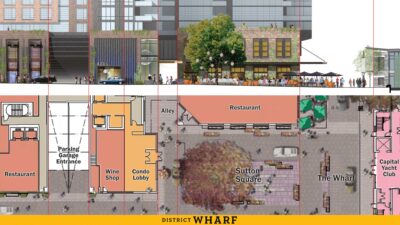
Figure 9: A focus on the ground level
In all the development that we are doing the emphasis is always on the public realm, which is in fact the way of creating private value. It is the public realm – the streets, the squares, the parks – that are the important part.
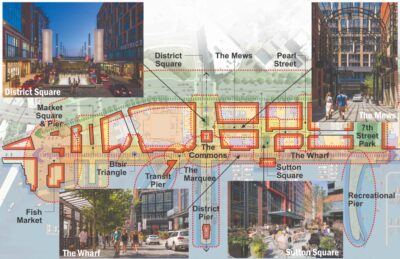
Figure 10: Emphasize the public realm
When we place an emphasis on creating the public realm, we have in mind making successful environments that are mostly enjoyed by the public but also serve many private building purposes. The Wharf D.C. is a good example of the idea of combining public and private places together as a partnership.
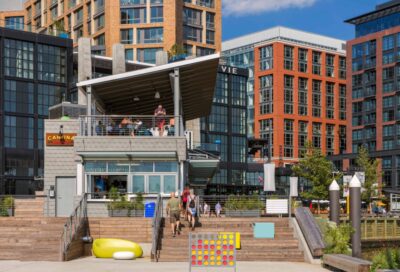
Figure 11: Wharf’s transit pier: Public space on the water
When you design buildings, you have to know how they get built. Implementation is where most of the large plans fail, and where they fail is in how they get started. The genius of these large plans lies in the first phase: You only get one shot at a first phase, just as there is only one first impression.
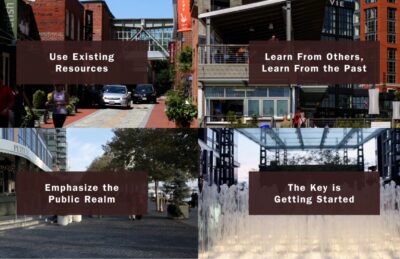
Figure 12: Key principles
The principles are a way of guiding everybody on how to do this work. There are no prototypes or formulas. Take the principles and make something uniquely appropriate to this one place on earth. Listen to everybody and include all interests and stakeholders, the more the better. Similarly, the more constraints that are included, the better.
All of which goes to make great cities.
Acknowledgements
The video is a Bagamor Media production for the Pittsburgh History & Landmarks Foundation.
The accompanying transcript has been slightly modified for this publication.
All images are courtesy of Perkins Eastman, New York City.
End

